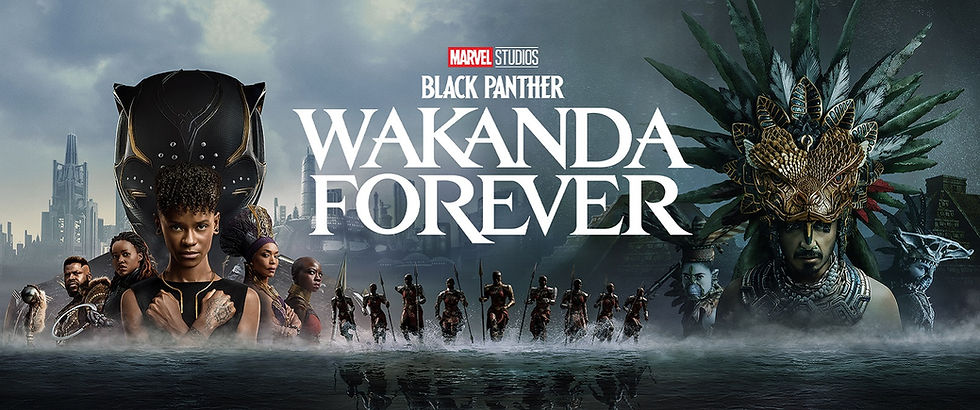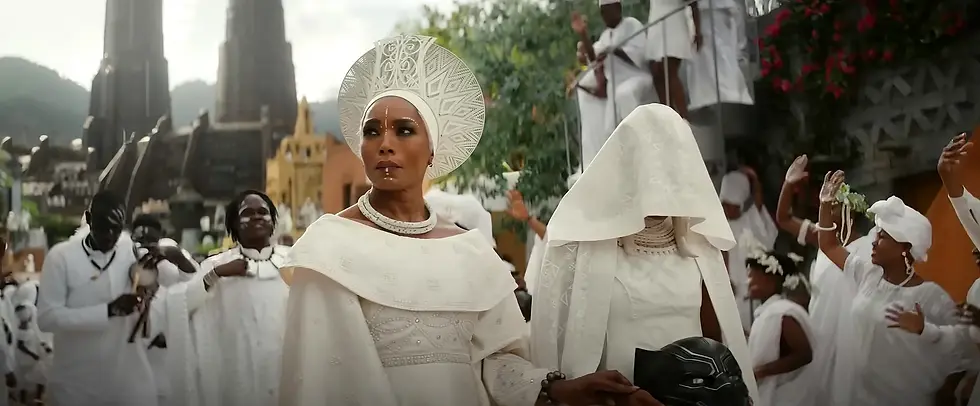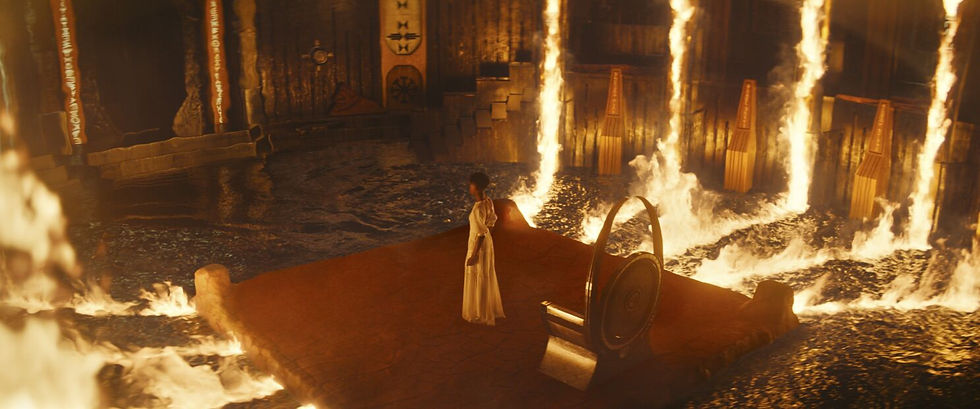In "Black Panther: Wakanda Forever" Grief is at the Forefront, but Healing Perseveres
- Vega

- Nov 12, 2022
- 5 min read
Updated: Dec 1, 2022
Release Date: November 11, 2022 Platform: In Theaters

This return to Wakanda is a bittersweet one. Though the culture-rich Black Panther franchise is a spectacle to behold with its honored traditions and powerful characters, the cloud of Chadwick Boseman’s passing lingers. The absence of King T’Challa/Black Panther fills every crevice of Black Panther: Wakanda Forever as Ryan Coogler (Creed, Black Panther) directs us through the ever engulfing grief of loss.
A year after losing their king and protector to an unnamed disease, Wakanda aims to secure its mantle as the most powerful nation in the eyes of the world as the foreign hunt for vibranium grows stronger. Using a new technology, vibranium is found deep in the ocean, drawing attention from the underwater civilization of Talokan and their king, Namor, portrayed by Tenoch Huerta Mejia. Blamed for exposing vibranium to the world, Queen Ramonda (Angela Bassett) and Princess Shuri (Letitia Wright) receive a threat from Namor himself: locate and hand over the scientist who created the technology, who is discovered to be Riri Williams (Dominique Thorne), or risk the wrath of Talokan. Underestimating the might of this hidden people, decisions are made that defy Namor’s wishes, leading to an all-out assault on Wakanda that results in huge casualties. Crumbling under the weight of shock, defeat, and death, Shuri, M’Baku (Winston Duke), Nakia (Lupita Nyong’o), Okoye (Danai Gurira), and Riri use the best of Wakanda’s resources to unite their warriors in a counter-strike against Namor and Talokan. Might and anger brew the perfect recipe for revenge, but to avoid the disaster of this war, the new Black Panther will need to seek the guidance of those who came before.
In the absence of the franchise’s lead, Wakanda Forever took more of an ensemble approach throughout the bulk of its story, though it does find itself ultimately landing on Wright’s Shuri as both the POV character and emotional anchor. There are powerful moments of sadness scattered throughout the film and Shuri was found front and center as she struggles through grief by means of avoidance and guilt. Her healing journey lends itself to the narrative’s direction, with her work through the stages of grief directly paralleling her character’s development, motivations, and decisions. Although Angela Bassett commanded the attention with her presence as Queen Ramonda, it was Shuri who commanded the film’s ever flowing emotional tone. She is never overshadowed, but the impact of her performance is directly challenged by the introduction of Namor and the depth of his character brought to justice by the excellent script and performance of Huerta. Namor is the best antagonist to be introduced in the last few years in the MCU, presenting the perfect antithesis to the Wakanda that T’Challa ushered in.

Hitting similar beats to the first film’s cultural focus, the time was taken to provide a fully realized Talokan, complete with origin, the current state of its citizens, and the motivations of its worshiped leader. Namor’s perspectives as both protector and leader shine through as his flight and strength are put on epic display and his political strategy to wage war with the surface world remained highlighted until the end. A glaring differential with the character is that he was not used nor treated as a one-off and remains an intriguing threat in the MCU. Namor also rose up the ranks of popularity for his use of the once forbidden “m” word that is slowly building prominence (that would be “mutant”). There are exchanges between him and Shuri in the second act that provided a slowdown of exposition and brings the strongly paced story to quite a halt. Although the movie earns almost all of its 161-minute run time, there are moments like this and Queen Ramonda’s visit to Haiti that could have benefited from more concise writing and editing. That said, the emotional breaks were welcomed regardless.
Drawing from his experience of the first film, Coogler drives home the style of this film with an engulfing soundtrack that deserves to remain on repeat and a very familiar third act that, fortunately, does not fall too far from the better grounded previous acts. It does end up feeling slightly formulaic due to the familiar climax carried by multiple altercations with frequent visits between them. Where it separates itself, though, is in the lead up to the climactic battle. While the emotional precedent set by this film has been well-established, there is also a strong political component to the character’s decisions, including in the strategizing for the final battle. There was less “fly by the seat of your pants” and hope for the best superpowers to win out. This took a much more grounded approach and was decided by tenacity and morals, helping the third act circle back to the narrative’s emotional core and this film’s dedication to its character-driven model.

Beyond the introductions of Namor and a new Black Panther was the debut of Riri Williams, a genius-level MIT student who will soon don the name Ironheart. As charming as Dominique Thorne’s debut was, there was a bit of an imbalance with her inclusion in the story. The plot devices leading to her entry were all done well, but the intimacy of this story did not lend much to the typical MCU-style flashiness that Riri and her suit ultimately brought. This notion extends to Okoye’s and Aneka’s outfitting as the Midnight Angels. All of these costumes were designed well and the Midnight Angels was a strong adaption from the comics, but the elaborate colors and high gloss against the backdrop of this particular film left their inclusions feeling like fish out of water.
There were a number of other intriguing decisions surrounding the supporting cast. M’Baku served a strong supporting role to Shuri that expanded on the evolution of his relationship with greater Wakanda. However, he ends up feeling underutilized to a limited screen time that rivals that of the previous installment. As its one true olive branch that extends this movie into the Phase 4 zeitgeists, the inclusion of Valentina Allegra de Fontaine (Julie Louis-Dreyfus) was a real surprise. As has been her M.O., she barely exists in the film, though much more is learned about her political status and connection to the returning Everett Ross (Martin Freeman). A bit of a stretch, perhaps, as she really proved unnecessary, even if the lifting of the veil was a bit exciting. The final surprise comes in the role that Queen Ramonda ultimately plays in the film, which cements the boldness of Coogler’s direction and the elevated stakes with which this story worked.

Emotions ran rampant, high stakes were realized, and Wakanda was forever changed even more than it was coming in to this much anticipated sequel. The biggest credit that could be given is that this story mattered, both within its cinematic world and in the real one. This is a war-drama that is treated with the upmost care within the envelope of superheroes. There is no reset at the end of this movie and every notable character undergoes some transformative development that breeds new life into the future of the franchise. From the touching tribute in the opening credits to the undying legacy teased in the mid-credits scene, Black Panther: Wakanda Forever sets itself apart as a well-crafted film with emotional maturity that rises beyond just the comic book movie genre. It may never be known what this film would have been had Chadwick Boseman remained with us, but what it became was the absolute pinnacle of the MCU post-Endgame.
RATING: 🌟 🌟 🌟 🌟.25 / 5
If you enjoyed this content, please follow Geeky Therapy on Facebook and Instagram to stay up to date with all posts and reviews.






Comments